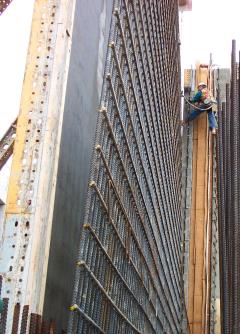Summary
Please enable javascript to play this video.
| Quick Facts: Ironworkers | |
|---|---|
|
$60,780 per year
$29.22 per hour |
|
| High school diploma or equivalent | |
| None | |
| Apprenticeship | |
| 94,400 | |
| 2% (As fast as average) | |
| 1,600 | |
What Ironworkers Do
Ironworkers install structural and reinforcing iron and steel to form and support buildings, bridges, and roads.
Work Environment
Ironworkers perform physically demanding and dangerous work, often at great heights. Workers must wear safety equipment to reduce the risk of falls or other injuries.
How to Become an Ironworker
Most ironworkers learn through an apprenticeship or on-the-job training.
Pay
The median annual wage for reinforcing iron and rebar workers was $54,850 in May 2023.
The median annual wage for structural iron and steel workers was $62,760 in May 2023.
Job Outlook
Overall employment of ironworkers is projected to grow 2 percent from 2022 to 2032, about as fast as the average for all occupations.
About 8,100 openings for ironworkers are projected each year, on average, over the decade. Many of those openings are expected to result from the need to replace workers who transfer to different occupations or exit the labor force, such as to retire.
State & Area Data
Explore resources for employment and wages by state and area for ironworkers.
Similar Occupations
Compare the job duties, education, job growth, and pay of ironworkers with similar occupations.
More Information, Including Links to O*NET
Learn more about ironworkers by visiting additional resources, including O*NET, a source on key characteristics of workers and occupations.
 United States Department of Labor
United States Department of Labor








